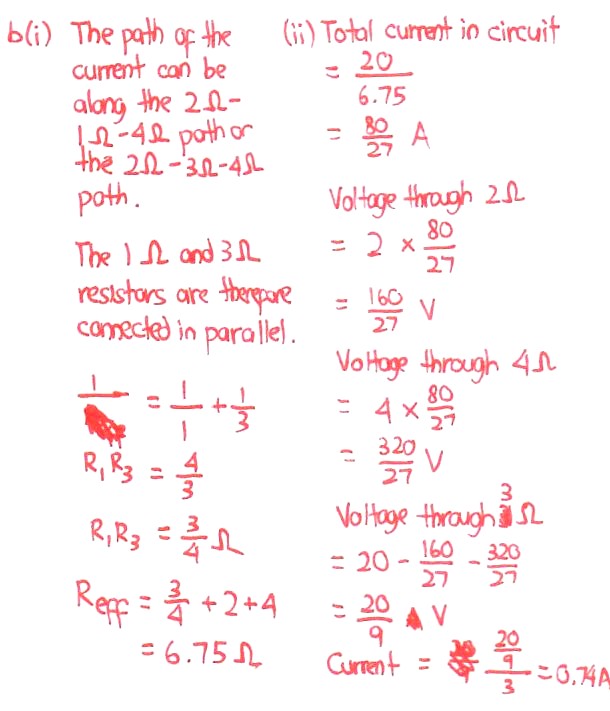Ask Singapore Homework?
Upload a photo of a Singapore homework and someone will email you the solution for free.

See 1 Answer
done
2 Upvotes
clear 0 Downvotes
For b (i), you have to recognise that the 1 ohm and 3 ohm resistors are connected in parallel, so you have to find the equivalent resistance value of thw two resistors before combining them to the 2 ohm and 4 ohm resistors in series.
For b (ii), you need to know these rules.
- In series circuits, current is always the same.
- In series circuits, voltage splits up from the main series branch into the different branches, but the voltage adds up to the same value as the main branch.
- In parallel circuits, voltage is always the same across branches.
- In parallel circuit / branches, current splits up from the main series branch into the different branches, but the current adds up to the same value as the main branch.
Since the 2 ohm and 4 ohm resistors are connected in series in the main branch while the 1 ohm and 3 ohm resistors are connected in parallel (connected to the main branch), we have
Current through 2 ohm = Current through 4 ohm = Total current through 1 ohm and 3 ohm
Voltage through 1 ohm = Voltage through 3 ohm; Voltage through 2 ohm + Voltage through 4 ohm + Voltage through 3 ohm (or 1 ohm, but not both) = Total voltage = 20 V.
For b (ii), you need to know these rules.
- In series circuits, current is always the same.
- In series circuits, voltage splits up from the main series branch into the different branches, but the voltage adds up to the same value as the main branch.
- In parallel circuits, voltage is always the same across branches.
- In parallel circuit / branches, current splits up from the main series branch into the different branches, but the current adds up to the same value as the main branch.
Since the 2 ohm and 4 ohm resistors are connected in series in the main branch while the 1 ohm and 3 ohm resistors are connected in parallel (connected to the main branch), we have
Current through 2 ohm = Current through 4 ohm = Total current through 1 ohm and 3 ohm
Voltage through 1 ohm = Voltage through 3 ohm; Voltage through 2 ohm + Voltage through 4 ohm + Voltage through 3 ohm (or 1 ohm, but not both) = Total voltage = 20 V.
Date Posted:
6 years ago





